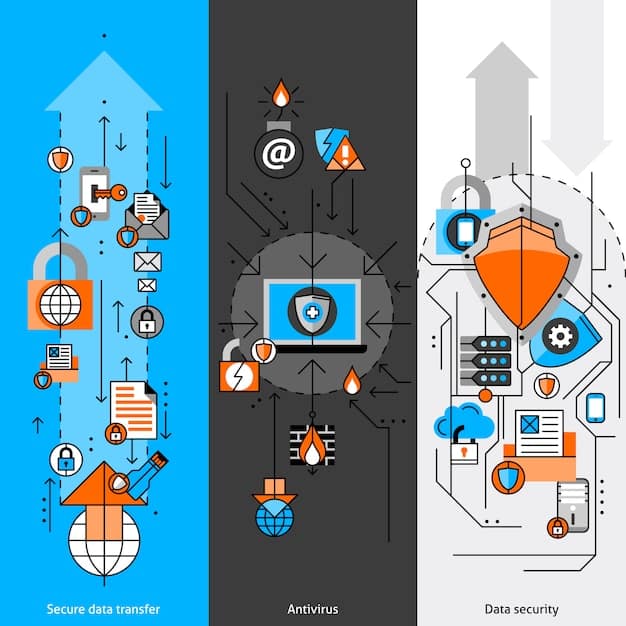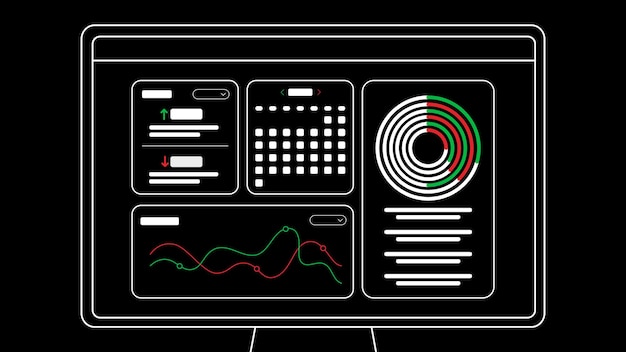Threat Intelligence Platforms (TIP): Improve US Threat Detection

Threat Intelligence Platforms (TIP) in the US aggregate and correlate threat data from multiple sources to improve the accuracy and speed of threat detection, enabling organizations to proactively defend against cyberattacks.
In today’s cybersecurity landscape, organizations in the US face a relentless barrage of sophisticated cyber threats. To effectively defend against these attacks, security teams need timely and actionable intelligence. Threat Intelligence Platforms (TIP) in the US play a vital role by aggregating, correlating, and analyzing threat data from various sources, ultimately improving threat detection and response capabilities.
Understanding Threat Intelligence Platforms (TIP) in the US
Threat Intelligence Platforms (TIPs) are a crucial component of a modern cybersecurity strategy, especially for organizations operating in the US. These platforms are designed to collect, aggregate, correlate, and analyze threat data from diverse sources, providing actionable insights that improve threat detection and response.
By centralizing threat intelligence, TIPs enable security teams to proactively identify and mitigate potential risks. This section will explore the core functionalities of TIPs and their significance in enhancing cybersecurity posture.
Key Functions of a Threat Intelligence Platform
A TIP serves as a central hub for processing and enriching threat data. Here’s a breakdown of its essential functions:
- Aggregation: Gathering threat data from multiple sources, including commercial feeds, open-source intelligence (OSINT), and internal logs.
- Correlation: Linking related threat indicators to identify patterns and campaigns.
- Analysis: Providing tools and techniques to analyze threat data, uncover insights, and prioritize alerts.
- Dissemination: Sharing actionable intelligence with security tools and teams to improve detection and response capabilities.
Benefits of Implementing a TIP
Implementing a TIP offers several advantages for organizations seeking to improve their cybersecurity defenses:
- Improved Threat Detection: By correlating data from multiple sources, TIPs can identify threats that might otherwise go unnoticed.
- Faster Incident Response: Actionable intelligence enables security teams to quickly respond to and contain security incidents.
- Enhanced Proactive Security: By understanding emerging threats, organizations can proactively strengthen their defenses.
- Better Resource Allocation: TIPs help prioritize security efforts by focusing on the most relevant and impactful threats.
In summary, Threat Intelligence Platforms are essential tools for organizations in the US looking to enhance their cybersecurity posture by centralizing, analyzing, and leveraging threat data effectively.

Sources of Threat Intelligence Data
A Threat Intelligence Platform (TIP) is only as effective as the data it receives. Therefore, understanding the various sources of threat intelligence data is crucial for maximizing the platform’s value. These sources can be broadly categorized into internal sources, external sources, and community-driven feeds.
Each type of source contributes unique perspectives and information, which, when combined, provide a comprehensive view of the threat landscape.
Internal Sources of Threat Intelligence
Internal data sources offer insights into threats specific to an organization’s environment. Common examples include:
- Security Information and Event Management (SIEM) Systems: Collect and analyze logs from various security devices and applications, providing insights into suspicious activities.
- Firewall Logs: Track network traffic and identify potential threats based on blocked connections and suspicious patterns.
- Intrusion Detection and Prevention Systems (IDS/IPS): Monitor network traffic for malicious activity and automatically block or mitigate threats.
External Sources of Threat Intelligence
External sources provide information about threats from the broader internet landscape. These sources are often categorized into commercial feeds and open-source intelligence (OSINT):
Commercial Threat Intelligence Feeds:
- Provide curated and verified threat data from specialized vendors, including indicators of compromise (IOCs), threat actor profiles, and malware analysis reports.
Open-Source Intelligence (OSINT):
- Consists of publicly available information gathered from sources like blogs, social media, forums, and research papers.
- Can provide valuable insights into emerging threats and vulnerabilities, but requires careful validation and analysis due to its unverified nature.
The effectiveness of a TIP relies on integrating diverse and high-quality threat intelligence feeds, ensuring a comprehensive view of the threat landscape and enabling proactive security measures.
Evaluating and Prioritizing Threat Intelligence Feeds
With numerous threat intelligence feeds available, it’s essential to evaluate and prioritize them effectively. This process involves assessing the relevance, accuracy, and timeliness of each feed to ensure that the TIP is processing high-quality and actionable data. Prioritization helps security teams focus on the most critical threats and avoid being overwhelmed by irrelevant information.
Understanding the evaluation process and implementing effective prioritization strategies are crucial for maximizing the value of threat intelligence.
Key Criteria for Evaluating Threat Intelligence Feeds
When evaluating threat intelligence feeds, consider the following factors:
- Relevance: Does the feed provide information relevant to your organization’s industry, geographic location, and technology stack?
- Accuracy: Is the information provided by the feed reliable and verified? Look for feeds with a strong reputation and clear validation processes.
- Timeliness: How quickly is the feed updated with new information? Timeliness is critical for detecting and responding to emerging threats.
Strategies for Prioritizing Threat Intelligence Feeds
To prioritize threat intelligence feeds, consider the following strategies:
- Risk-Based Approach: Prioritize feeds that provide information about threats that pose the greatest risk to your organization’s assets and operations.
- Relevancy Scoring: Assign scores to feeds based on their relevance to your organization’s specific threat profile and business objectives.
- Feedback Loops: Continuously monitor the effectiveness of each feed and adjust prioritization accordingly based on historical performance and incident response outcomes.

Integrating TIP with Security Tools
Integrating a Threat Intelligence Platform (TIP) with existing security tools is crucial for operationalizing threat intelligence and maximizing its impact. This integration enables security teams to automate threat detection and response, improve the effectiveness of security controls, and streamline security workflows. By seamlessly sharing actionable intelligence with other security tools, organizations can proactively defend against cyber threats and minimize the impact of security incidents.
This section explores the importance of integration and provides insights into how to effectively connect a TIP with security infrastructure.
Benefits of Integrating TIP with Security Tools
Integrating a TIP with security tools offers several key advantages:
- Automated Threat Detection: Automatically update security tools with the latest threat intelligence, enabling real-time detection of malicious activity.
- Improved Security Efficacy: Enhance the effectiveness of existing security controls by providing them with context-rich threat intelligence.
- Streamlined Security Workflows: Automate security tasks, such as incident response and threat hunting, by providing security teams with actionable intelligence.
- Reduced False Positives: Improve the accuracy of security alerts by correlating them with threat intelligence data, reducing false positives and alert fatigue.
Common Integration Points for TIP
A TIP can be integrated with various security tools and systems:
- Security Information and Event Management (SIEM) Systems: Share threat intelligence data with SIEMs to improve threat detection and incident analysis.
- Firewalls and Intrusion Prevention Systems (IPS): Automatically block malicious traffic based on threat intelligence data.
- Endpoint Detection and Response (EDR) Solutions: Enhance endpoint protection by providing EDR solutions with threat intelligence about known malware and attack techniques.
- Vulnerability Scanners: Prioritize vulnerability remediation efforts based on threat intelligence about actively exploited vulnerabilities.
In conclusion, integrating a TIP with security tools is essential for operationalizing threat intelligence and maximizing its value, enabling organizations to automate threat detection and response, improve security efficacy, and streamline security workflows.
Measuring the Effectiveness of a TIP
Measuring the effectiveness of a Threat Intelligence Platform (TIP) is critical to demonstrate its value, justify its investment, and continuously improve its performance. By tracking key metrics and analyzing the impact of threat intelligence on security operations, organizations can gain insights into the effectiveness of their TIP deployment and identify areas for optimization.
Understanding the measurement process and implementing relevant metrics are essential for maximizing the return on investment in threat intelligence.
Key Metrics for Measuring TIP Effectiveness
When measuring the effectiveness of a TIP, consider the following metrics:
- Threat Detection Rate: The percentage of threats detected due to threat intelligence provided by the TIP.
- Time to Detect (TTD): The average time it takes to detect a threat after it enters the environment, compared to the baseline before TIP implementation.
- Time to Respond (TTR): The average time it takes to respond to a security incident, including investigation, containment, and remediation.
Analyzing the Impact of Threat Intelligence
To analyze the impact of threat intelligence, consider the following questions:
- Has threat intelligence enabled the detection of threats that would have otherwise gone unnoticed?
- Has threat intelligence helped to prioritize and focus security efforts on the most relevant and impactful threats?
- Has threat intelligence led to a reduction in the number and severity of security incidents?
Measuring the effectiveness of a TIP is an ongoing process that requires continuous monitoring, analysis, and optimization to ensure that it is delivering value and improving the organization’s security posture.
Best Practices for Implementing a Threat Intelligence Platform in the US
Implementing a Threat Intelligence Platform (TIP) effectively involves more than just deploying the technology. It requires a strategic approach that aligns with the organization’s security objectives, risk profile, and existing security infrastructure. Adhering to best practices ensures that the TIP delivers maximum value and effectively enhances the organization’s cybersecurity posture. These best practices encompass planning, implementation, and ongoing management.
By following these guidelines, organizations in the US can successfully implement and leverage TIPs to improve threat detection, incident response, and proactive security.
Defining Clear Objectives and Goals
Before implementing a TIP, define clear objectives and goals that align with the organization’s security priorities. These objectives might include:
- Improving threat detection rates.
- Reducing the time to detect and respond to security incidents.
- Enhancing proactive security measures.
Selecting the Right TIP Solution
Consider the following factors when selecting a TIP solution:
- Integration capabilities with existing security tools.
- Scalability to support future growth.
- User-friendliness and ease of administration.
Establishing a Threat Intelligence Team
Build a dedicated threat intelligence team with the necessary skills and expertise to manage the TIP and leverage its capabilities. This team should be responsible for:
- Collecting and analyzing threat intelligence data.
- Developing and implementing threat intelligence workflows.
- Sharing threat intelligence with other security teams and stakeholders.
| Key Point | Brief Description |
|---|---|
| 📊 Understanding TIPs | TIPs aggregate and correlate threat data, improving threat detection. |
| 🔍 Threat Data Sources | Internal and external sources provide comprehensive insights. |
| ⚙️ Integration is Key | Integrate TIPs with security tools for automated threat detection. |
| 🎯 Measuring Success | Track metrics like threat detection rate and TTR to measure effectiveness. |
Frequently Asked Questions (FAQ)
▼
A TIP is a technology solution allowing organizations to collect, aggregate, correlate, and analyze threat data from various sources. It enables better threat detection and response.
▼
Threat intelligence provides US organizations with insights into emerging threats, attack patterns, and vulnerabilities, enabling them to proactively defend against cyberattacks.
▼
Primary data sources include internal sources like SIEM and firewalls, and external sources such as commercial threat feeds and open-source intelligence (OSINT).
▼
Integration enables automated threat detection, improves the efficacy of security controls, streamlines security workflows, and reduces false positives.
▼
Key metrics include threat detection rate, time to detect (TTD), and time to respond (TTR). These metrics help organizations assess the value of their TIP implementation.
Conclusion
In conclusion, Threat Intelligence Platforms (TIP) in the US are essential for organizations seeking to enhance their cybersecurity posture. By aggregating and correlating threat data from multiple sources, TIPs improve threat detection and response capabilities, enabling organizations to proactively defend against cyberattacks and minimize the impact of security incidents.





